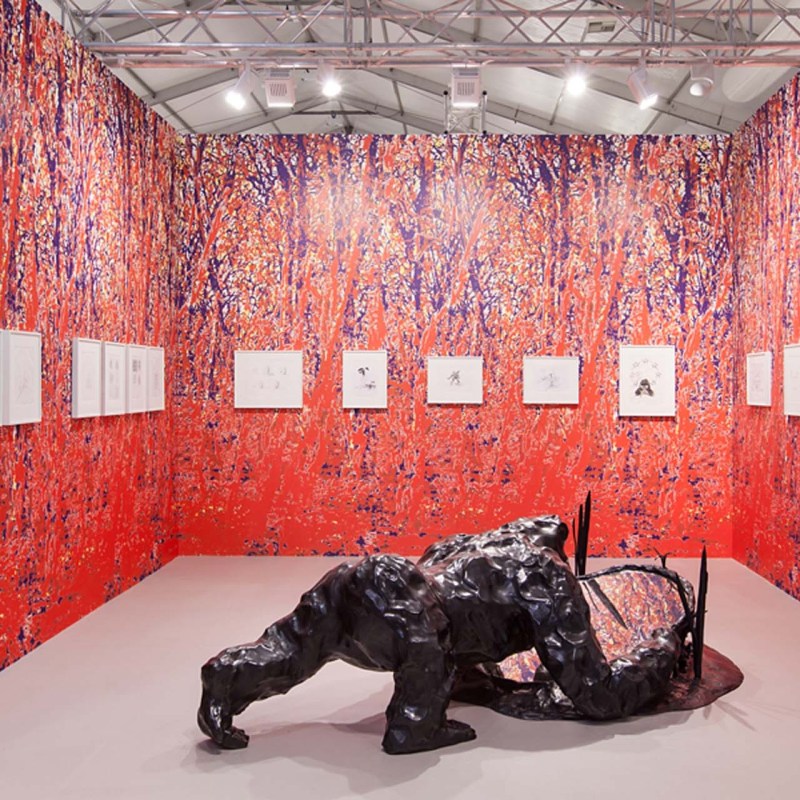Angus Fairhurst (1966-2008), one of the influential members of the group of artists associated with London’s Goldsmiths College in the late 1980s, participated in the seminal exhibition, Freeze, in 1988, which introduced the world to a generation who became known as the Young British Artists. This set the tone for contemporary art in the UK over the next two decades. Fairhurst’s work resists straightforward categorisation, encompassing sculpture, painting, performance, animation, photography, video, music, printmaking, drawing and collage.
Angus Fairhurst’s drawings epitomise his offbeat and often melancholy humour, his experiments with figuration, and his use of gorillas as figures of pathetic buffoonery and otherworldliness. The emergence of the gorilla as a motif in Fairhurst’s art can be traced back to a show of his drawings at Sarah Lucas’s London flat in 1994. Ranging between adroitly sketched studies and minutely rendered drawings, his works in pencil or pen regularly present gorillas in surreal human situations – for instance propping up a bar, holding a man in the pose of the pieta, or wrestling with a snake in a loose approximation of the famous GrecoRoman sculpture the Laocoön. More sombrely, one such work shows crows devouring a human figure while his discarded outfits – a furry gorilla suit and a human mask – lie on the floor around him.
At times, the gorilla becomes a stand in for Fairhurst himself, his imaginative other. Fairhurst attributed the pathos of his gorilla scenarios to a further kind of otherness – “a discrepancy between many idealised things and their everyday reality.” In the figure of the gorilla, Fairhurst moreover shadows forth man’s animal ‘other’. Bestial yet approximate to the human form, he identified gorillas as inherently anthropomorphic: “Gorillas are a useful image because they’re very close to the human shape, so you can draw them doing human activities without having to characterize or personalize them. They represent a certain kind of thing in mankind.” Other drawings feature anthropomorphic inventions such as an armchair endowed with human legs, or a double-ended pair of legs (a motif also found in Fairhurst’s early digital animations) variously flailing or suspended in elegant counterpoise or locked in a clumsy antagonism (The Trouble with Comedy No. 5; The Trouble with Comedy No. 9; The Trouble with Comedy).
The Birth of Consistency (2004) shows a gorilla – one of the recurring motifs of Fairhurst’s work – contemplating itself in a mirrored pool and wrenching the reflective surface towards itself. It is one of a series of works in bronze from the mid-2000s depicting gorillas in a variety of surreal scenarios. Modelled from clay and cast on miniature or life-size scales, Fairhurst’s gorillas were the sculptural successors to his anthropomorphic drawings of the 1990s (he once remarked that he “wanted to make a classical sculpture which has the lightness of a cartoon”). Each shows the gorilla in an absurdist and doleful scenario – for instance contemplating its own detached arm, or holding its detached head aloft. Here, the artist alludes to the classical myth of Narcissus, casting the gorilla in the role of the doomed boy who fell in love with his reflection. The title refers to the stage at which the human brain becomes capable of conceptualising visual representations – famously theorised by Jacques Lacan as le stade du miroir or the ‘mirror stage’. The gorilla is confronting its own image, but also perhaps apprehending its own status as an artwork and a construct. Indeed, the work wears its artifice openly; there is a an air of theatricality about the manoeuvrable pond and the uniformly black patina of the gorilla, ponds and rushes. Here and in many works, Fairhurst constructed a kind of ‘fake nature’ – a celebration of the pastoral and mythological realms that also affectionately pricked their artifice.
Undone (2002) is a life-size cast of a banana in silver – one of a many sculptures that recast the imagery of Fairhurst’s early tragicomic cartoons, including gorillas and ponds. It reprises a key slapstick motif that recurs throughout Fairhurst’s work: the banana is for instance given monumental bronze form in Undone (2004), and presented as a splayed-out skin in the bright yellow resin piece The Problem With Banana Skins Divided/Inverted (1998). These works compress in comic form many of the artist’s presiding concerns, whether with nature, the romantic pastoral genre, or cycles of regeneration and decay. Undone manages to be simultaneously totemic and comic, ponderous and light: the arcane associations of silverwork are ‘undone’ by the unserious (potentially rude) subject matter. The concept of ‘undoing’ pervaded Fairhurst’s practice – absence was an ever-present motif. Words such as ‘unwritten’, ‘undone’, and ‘untouched’ formed many of his titles.
Fairhurst graduated from Goldsmiths College in London in 1989. Following Freeze, he exhibited in most of the landmark group exhibitions of his generation, including Gambler (1991) at Building One, London, Brilliant at the Walker Art Centre in Minneapolis (1995), Some Went Mad, Some Ran Away at the Serpentine (1994), Apocalypse at the Royal Academy (2000), Casino 2001 at SMAK in Ghent (2001), and In-a-Gadda-da-Vida, with Sarah Lucas and Damien Hirst, at Tate Britain (2004). He also had a number of significant one-person exhibitions, notably at Spacex Gallery, Exeter (2001), and at Ursula Blickle Stiftung, Kraichtal, Germany and Kunsthalle St.Gallen, Switzerland (1999). Music performances by Fairhurst’s band, originally called Low Expectations, took place at an international range of venues from 1995-2001. From 2009-11, a touring retrospective of his work travelled between Arnolfini, Bristol; Waddesdon Manor, Buckinghamshire; M Museum, Leuven, Belgium; and Westfälischer Kunstverein, Muenster, Germany.
For further information please contact the gallery at +44 (0)20 7493 8611 or press@sadiecoles.com
